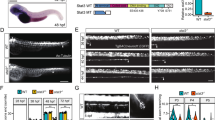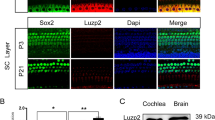Abstract
The tumor suppressor gene liver kinase B1 (LKB1), also called STK11, encodes a serine/threonine kinase. LKB1 plays crucial roles in cell differentiation, proliferation, and polarity. In this study, LKB1 conditional knockout mice (LKB1Pax2 CKO mice) were generated using Pax2-Cre mice to investigate the function of LKB1 in inner ear hair cells during early embryonic period. LKB1Pax2 CKO mice died perinatally. Immunofluorescence and scanning electron microscopy revealed that stereociliary bundles in LKB1Pax2 CKO mice were clustered and misoriented, respectively. Moreover, ectopic distribution of kinocilium bundles resulting from abnormal migration of kinocilium was observed in the mutant mice. The orientation of stereociliary bundles and the migration of kinocilia are critical indicators of planar cell polarity (PCP) of hair cells. LKB1 deficiency in LKB1Pax2 CKO mice thus disrupted hair cell planar polarity during embryonic development. Our results suggest that LKB1 is required in PCP formation in cochlear hair cells in mice.
Similar content being viewed by others
References
Holley MC. The auditory system, hearing loss and potential targets for drug development. Drug Discov Today 2005; 10(19): 1269–1282
Frolenkov GI, Belyantseva IA, Friedman TB, Griffith AJ. Genetic insights into the morphogenesis of inner ear hair cells. Nat Rev Genet 2004; 5(7): 489–498
Petit C, Richardson GP. Linking genes underlying deafness to hairbundle development and function. Nat Neurosci 2009; 12(6): 703–710
Ueyama T, Sakaguchi H, Nakamura T, Goto A, Morioka S, Shimizu A, Nakao K, Hishikawa Y, Ninoyu Y, Kassai H, Suetsugu S, Koji T, Fritzsch B, Yonemura S, Hisa Y, Matsuda M, Aiba A, Saito N. Maintenance of stereocilia and apical junctional complexes by Cdc42 in cochlear hair cells. J Cell Sci 2014; 127(Pt 9): 2040–2052
Perrin BJ, Strandjord DM, Narayanan P, Henderson DM, Johnson KR, Ervasti JM. ß-Actin and fascin-2 cooperate to maintain stereocilia length. J Neurosci 2013; 33(19): 8114–8121
Francis SP, Krey JF, Krystofiak ES, Cui R, Nanda S, Xu W, Kachar B, Barr-Gillespie PG, Shin JB. A short splice form of Xin-actin binding repeat containing 2 (XIRP2) lacking the Xin repeats is required for maintenance of stereocilia morphology and hearing function. J Neurosci 2015; 35(5): 1999–2014
Sanchez-Cespedes M. A role for LKB1 gene in human cancer beyond the Peutz-Jeghers syndrome. Oncogene 2007; 26(57): 7825–7832
Baas AF, Smit L, Clevers H. LKB1 tumor suppressor protein: PARtaker in cell polarity. Trends Cell Biol 2004; 14(6): 312–319
Ylikorkala A, Rossi DJ, Korsisaari N, Luukko K, Alitalo K, Henkemeyer M, Mäkelä TP. Vascular abnormalities and deregulation of VEGF in Lkb1-deficient mice. Science 2001; 293(5533): 1323–1326
Koh HJ, Arnolds DE, Fujii N, Tran TT, Rogers MJ, Jessen N, Li Y, Liew CW, Ho RC, Hirshman MF, Kulkarni RN, Kahn CR, Goodyear LJ. Skeletal muscle-selective knockout of LKB1 increases insulin sensitivity, improves glucose homeostasis, and decreases TRB3. Mol Cell Biol 2006; 26(22): 8217–8227
Ikeda Y, Sato K, Pimentel DR, Sam F, Shaw RJ, Dyck JR, Walsh K. Cardiac-specific deletion of LKB1 leads to hypertrophy and dysfunction. J Biol Chem 2009; 284(51): 35839–35849
Ohashi K, Ouchi N, Higuchi A, Shaw RJ, Walsh K. LKB1 deficiency in Tie2-Cre-expressing cells impairs ischemia-induced angiogenesis. J Biol Chem 2010; 285(29): 22291–22298
Sun G, Reynolds R, Leclerc I, Rutter GA. RIP2-mediated LKB1 deletion causes axon degeneration in the spinal cord and hind-limb paralysis. Dis Model Mech 2011; 4(2): 193–202
Men Y, Zhang A, Li H, Zhang T, Jin Y, Li H, Zhang J, Gao J. LKB1 is required for the development and maintenance of stereocilia in inner ear hair cells in mice. PLoS ONE 2015; 10(8): e0135841
Ruben RJ. Development of the inner ear of the mouse: a radioautographic study of terminal mitoses. Acta Otolaryngol 1967; Suppl 220: 1–44
Mates M. Atlas of anatomy: general anatomy and musculoskeletal system. Occup Ther Health Care 2008; 22(4): 76–77
Barald KF, Kelley MW. From placode to polarization: new tunes in inner ear development. Development 2004; 131(17): 4119–4130
Chen P, Segil N. p27(Kip1) links cell proliferation to morphogenesis in the developing organ of Corti. Development 1999; 126(8): 1581–1590
Chen P, Johnson JE, Zoghbi HY, Segil N. The role of Math1 in inner ear development: uncoupling the establishment of the sensory primordium from hair cell fate determination. Development 2002; 129(10): 2495–2505
Wang J, Mark S, Zhang X, Qian D, Yoo SJ, Radde-Gallwitz K, Zhang Y, Lin X, Collazo A, Wynshaw-Boris A, Chen P. Regulation of polarized extension and planar cell polarity in the cochlea by the vertebrate PCP pathway. Nat Genet 2005; 37(9): 980–985
Yang H, Xie X, Deng M, Chen X, Gan L. Generation and characterization of Atoh1-Cre knock-in mouse line. Genesis 2010; 48(6): 407–413
Ohyama T, Groves AK. Generation of Pax2-Cre mice by modification of a Pax2 bacterial artificial chromosome. Genesis 2004; 38(4): 195–199
Nakada D, Saunders TL, Morrison SJ. Lkb1 regulates cell cycle and energy metabolism in haematopoietic stem cells. Nature 2010; 468 (7324): 653–658
Sung JY, Woo CH, Kang YJ, Lee KY, Choi HC. AMPK induces vascular smooth muscle cell senescence via LKB1 dependent pathway. Biochem Biophys Res Commun 2011; 413(1): 143–148
Ross AJ, May-Simera H, Eichers ER, Kai M, Hill J, Jagger DJ, Leitch CC, Chapple JP, Munro PM, Fisher S, Tan PL, Phillips HM, Leroux MR, Henderson DJ, Murdoch JN, Copp AJ, Eliot MM, Lupski JR, Kemp DT, Dollfus H, Tada M, Katsanis N, Forge A, Beales PL. Disruption of Bardet-Biedl syndrome ciliary proteins perturbs planar cell polarity in vertebrates. Nat Genet 2005; 37(10): 1135–1140
Jones C, Chen P. Primary cilia in planar cell polarity regulation of the inner ear. Curr Top Dev Biol 2008; 85: 197–224
Tilney LG, Tilney MS, De Rosier DJ. Actin filaments, stereocilia, and hair cells: how cells count and measure. Annu Rev Cell Biol 1992; 8(1): 257–274
Cui C, Chatterjee B, Francis D, Yu Q, San Agustin JT, Francis R, Tansey T, Henry C, Wang B, Lemley B, Pazour GJ, Lo CW. Disruption of Mks1 localization to the mother centriole causes cilia defects and developmental malformations in Meckel-Gruber syndrome. Dis Model Mech 2011; 4(1): 43–56
Sipe CW, Lu X. Kif3a regulates planar polarization of auditory hair cells through both ciliary and non-ciliary mechanisms. Development 2011; 138(16): 3441–3449
May-Simera H, Kelley MW. Planar cell polarity in the inner ear. Curr Top Dev Biol 2012; 101: 111–140
Curtin JA, Quint E, Tsipouri V, Arkell RM, Cattanach B, Copp AJ, Henderson DJ, Spurr N, Stanier P, Fisher EM, Nolan PM, Steel KP, Brown SD, Gray IC, Murdoch JN. Mutation of Celsr1 disrupts planar polarity of inner ear hair cells and causes severe neural tube defects in the mouse. Curr Biol 2003; 13(13): 1129–1133
Montcouquiol M, Rachel RA, Lanford PJ, Copeland NG, Jenkins NA, Kelley MW. Identification of Vangl2 and Scrb1 as planar polarity genes in mammals. Nature 2003; 423(6936): 173–177
Wang Y, Guo N, Nathans J. The role of Frizzled3 and Frizzled6 in neural tube closure and in the planar polarity of inner-ear sensory hair cells. J Neurosci 2006; 26(8): 2147–2156
Forge A, Souter M, Denman-Johnson K. Structural development of sensory cells in the ear. Semin Cell Dev Biol 1997; 8(3): 225–237
Rida PC, Chen P. Line up and listen: planar cell polarity regulation in the mammalian inner ear. Semin Cell Dev Biol 2009; 20(8): 978–985
Spicer J, Rayter S, Young N, Elliott R, Ashworth A, Smith D. Regulation of the Wnt signalling component PAR1A by the Peutz-Jeghers syndrome kinase LKB1. Oncogene 2003; 22(30): 4752–4756
Lin-Marq N, Borel C, Antonarakis SE. Peutz-Jeghers LKB1 mutants fail to activate GSK-3ß, preventing it from inhibiting Wnt signaling. Mol Genet Genomics 2005; 273(2): 184–196
Almuedo-Castillo M, Saló E, Adell T. Dishevelled is essential for neural connectivity and planar cell polarity in planarians. Proc Natl Acad Sci USA 2011; 108(7): 2813–2818
Jenny A, Reynolds-Kenneally J, Das G, Burnett M, Mlodzik M. Diego and Prickle regulate Frizzled planar cell polarity signalling by competing for Dishevelled binding. Nat Cell Biol 2005; 7(7): 691–697
Axelrod JD, Miller JR, Shulman JM, Moon RT, Perrimon N. Differential recruitment of Dishevelled provides signaling specificity in the planar cell polarity and Wingless signaling pathways. Genes Dev 1998; 12(16): 2610–2622
Winter CG, Wang B, Ballew A, Royou A, Karess R, Axelrod JD, Luo L. Drosophila Rho-associated kinase (Drok) links Frizzledmediated planar cell polarity signaling to the actin cytoskeleton. Cell 2001; 105(1): 81–91
Usui T, Shima Y, Shimada Y, Hirano S, Burgess RW, Schwarz TL, Takeichi M, Uemura T. Flamingo, a seven-pass transmembrane cadherin, regulates planar cell polarity under the control of Frizzled. Cell 1999; 98(5): 585–595
Author information
Authors and Affiliations
Corresponding authors
Rights and permissions
About this article
Cite this article
Men, Y., Zhang, A., Zhang, L. et al. Loss of liver kinase B1 causes planar polarity defects in cochlear hair cells in mice. Front. Med. 10, 481–489 (2016). https://doi.org/10.1007/s11684-016-0494-3
Received:
Accepted:
Published:
Issue Date:
DOI: https://doi.org/10.1007/s11684-016-0494-3




